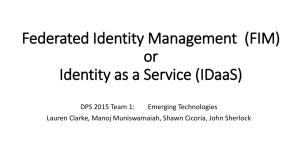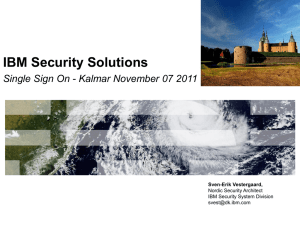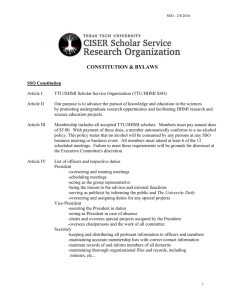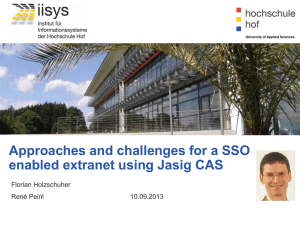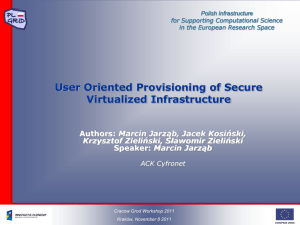Cloud Computing Chap..
advertisement
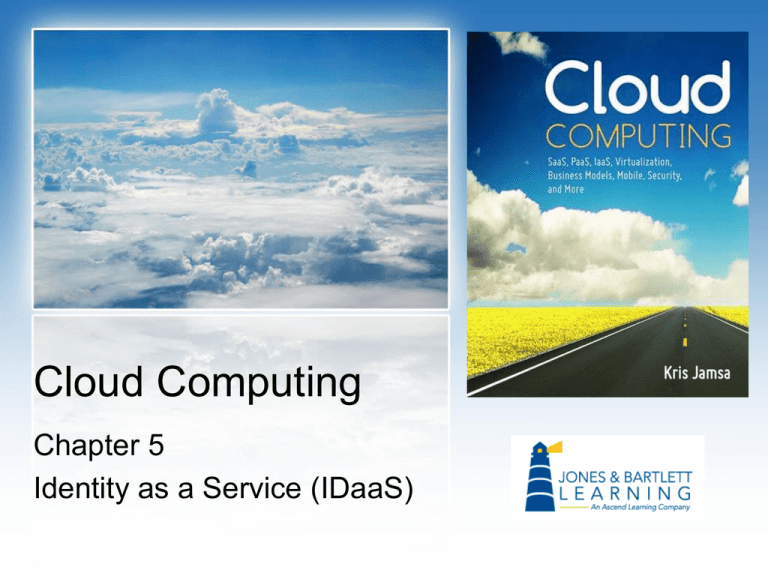
Cloud Computing Chapter 5 Identity as a Service (IDaaS) Learning Objectives • • • • Describe challenges related to ID management. Describe and discuss single sign-on (SSO) capabilities. List the advantages of IDaaS solutions. Discuss IDaaS solutions offered by various companies. IDaaS Defined • Identity (or identification) as a service (IDaaS)— Cloud-based approaches to managing user identities, including usernames, passwords, and access. Also sometimes referred to as “identity management as a service. Single Sign-On (SSO) • Single sign-on (SSO)—PA process that allows a user to log into a central authority and then access other sites and services for which he or she has credentials. Advantages of SSO • Fewer username and password combinations for users to remember and manage • Less password fatigue caused by the stress of managing multiple passwords • Less user time consumed by having to log in to individual systems • Fewer calls to help desks for forgotten passwords • A centralized location for IT staff to manage password compliance and reporting Disadvantages of SSO • The primary disadvantage of SSO systems is the potential for a single source of failure. If the authentication server fails, users will not be able to log in to other servers. • Thus, having a cloud-based authentication server with system redundancy reduces the risk of system unavailability. How SSO Works Federated ID Management • FIDM describes the technologies and protocols that combine to enable a user to bring security credentials across different security domains (different servers running potentially different operating systems). Security Assertion Markup Language (SAML) • Behind the scenes, many FIDM systems use the Security Assertion Markup Language (SAML) to package a user’s security credentials. Account Provisioning • The process of creating a user account on a system is called account provisioning. • Because different employees may need different capabilities on each system, the provisioning process can be complex. • When an employee leaves the company, a deprovisioning process must occur to remove the user’s accounts. Deprovisioning Problem • Unfortunately, the IT staff is not always immediately informed that an employee no longer works for the company, or the IT staff misses a server account and the user may still have access to one or more systems. 4 A’s of Cloud Identity • Authentication: The process of validating a user for on-site and cloud-based solutions. • Authorization: The process of determining and specifying what a user is allowed to do on each server. • Account management: The process of synchronizing user accounts by provisioning and deprovisioning access. • Audit logging: The process of tracking which applications users access and when. Real World: Ping Identity IDaaS • Ping Identity provides cloud-based ID management software that supports FIDM and user account provisioning. Real World: PassworkBank IDaaS • PasswordBank provides an IDaaS solution that supports on-site and cloud-based system access. Its FIDM service supports enterprise-wide SSO (ESSO) and SSO for web-based applications (WebSSO). • The PasswordBank solutions perform the FIDM without the use of SAML. • PasswordBank solutions support a myriad of devices, including the iPhone. OpenID • OpenID allows users to use an existing account to log in to multiple websites. Today, more than 1 billion OpenID accounts exist and are accepted by thousands of websites. • Companies that support OpenID include Google, Yahoo!, Flickr, Myspace, WordPress.com, and more Advantages of Using OpenID • Increased site conversion rates (rates at which customers choose to join websites) because users do not need to register • Access to greater user profile content • Fewer problems with lost passwords • Ease of content integration into social networking sites Mobile ID Management • Threats to mobile devices include the following: – – – – – – Identity theft if a device is lost or stolen Eavesdropping on data communications Surveillance of confidential screen content Phishing of content from rogue sites Man-in-the-middle attacks through intercepted signals Inadequate device resources to provide a strong security implementation – Social attacks on unaware users that yield identity information Key Terms Chapter Review 1. Define and describe SSO. 2. Define and describe IDaaS. 3. Define SAML and describe its purpose. 4. Define and describe provisioning. 5. Define and describe FIDM. 6. List factors that make mobile ID management difficult.
